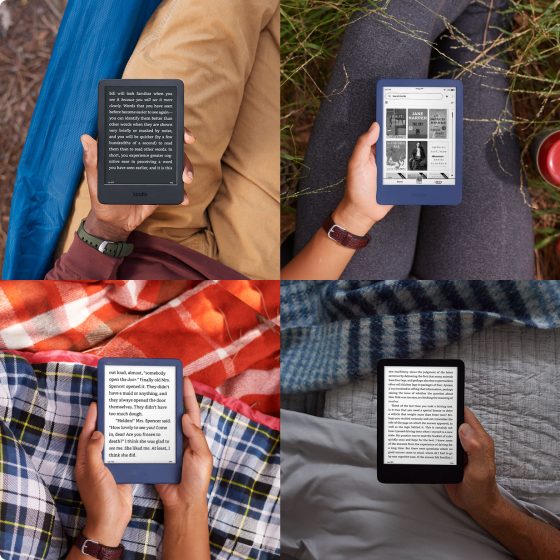For people that are new to Kindles and ereaders in general they often have questions about how the screen is different than other types of screens on phones, tablets, and TVs.
Amazon doesn’t help matters any by never actually calling the screens what they are like other companies do; their marketing department tries to make it sound like Amazon makes the screens but they don’t. Kindles use E Ink screens, like all dedicated ereaders, and they’re all made by the same company: E Ink.
E Ink screens are a lot different than LCD screens. For one, they’re meant to look more paper-like, and unlike typical LCD screens, E Ink screens don’t actually use power to display text and images—they only use power when changing the content on the screen, when the ink pixels get rearranged, which sometimes causes the screen to flash when doing a full page refresh (usually at chapters or after images).
Secondly, E Ink screens aren’t backlit and they can be viewed in bright light without glare and reflections, even direct sunlight without the screen getting washed out.
Another key detail about E Ink screens is they’re black and white only. At least all the main ones for ereaders are, but there are a few with color screens. Color E Ink has some drawbacks and is a lot more expensive so it hasn’t really caught on yet and maybe never will, but a color Kindle might come along eventually if the technology gets better.
Anyway, I noticed Amazon talks a little bit about how Kindle screens are different from tablet screens on the product page for the newest 2022 Kindle. It’s kind of funny because it’s not something mentioned on the product pages for other Kindles, despite all of them having the same type of screen.
Here’s the quote from the Frequently Asked Questions section of the product page for the 2022 Kindle:
1. How is the screen on a Kindle different from a tablet?
Our Kindle devices are designed so you can read comfortably for hours. Kindle has a unique black and white glare-free display that reads like paper even in bright sunlight and enables weeks of battery life. With the display’s distinctive nature, slight shadows of previous text or images can sometimes remain visible on the screen. The display quickly refreshes occasionally to remove these shadows and ensure a high-quality optical experience.
Those last two sentences are particually interesting. I don’t recall Amazon referencing ghosting on a Kindle’s display before. It’s common to see some afterimage effects on E Ink screens, but they’ve gotten a lot better in recent years.
I barely ever notice ghosting on the Kindle Paperwhite’s screen, and the Kindle Scribe is pretty good in that regard too. When I go back to using the Kindle Oasis I notice it shows way more ghosting than other Kindles for some reason. If anything that disclaimer should be on the product page for it instead of the basic Kindle. Nevertheless, I hadn’t noticed that section before and thought it was kind of interesting.


I know the battery life averages are based on something like an hour’s reading/day.. I’m never get a week because I read a LOT. However, given the amount I read, getting close to a week is good.
I own two Kindle Oasis. But I read on my large Samsung tablets. I prefer light text on a dark background. The Kindles achieve a dark gray at best. In most environments the depper black background on the tablets is easier on my (troublesome) eyes.
Why are E-ink screens never used with mobile phones? I understand that color screens are best suited for mobile phones because more than 50% of content is graphical and graphic illustrations best work in color, but what other reasons were responsible for this ostracism ? I appreciate all the comments directed towards my question.
Hisense sells E Ink phones in China and has for several years, but I think it’s just too niche of a market for most people to care about. A phone with no color or washed-out color and stuttering video isn’t going to be very popular in this the day and age, especially when they cost as much or more than phones with regular LCD screens.